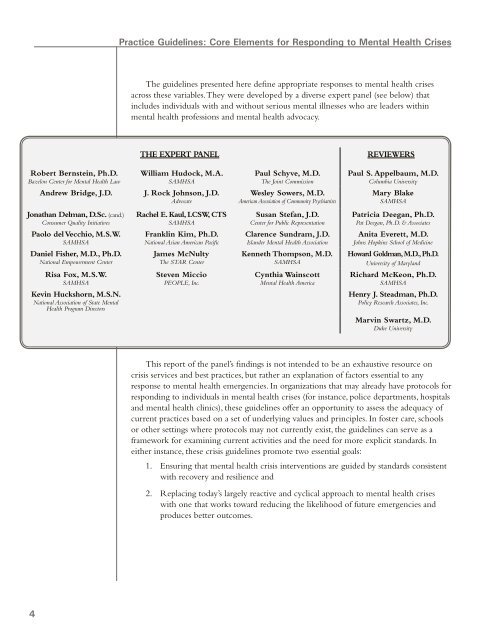Practice Guidelines: Core Elements for Responding to Mental Health
Practice Guidelines: Core Elements for Responding to Mental Health
Practice Guidelines: Core Elements for Responding to Mental Health
You also want an ePaper? Increase the reach of your titles
YUMPU automatically turns print PDFs into web optimized ePapers that Google loves.
<strong>Practice</strong> <strong>Guidelines</strong>: <strong>Core</strong> <strong>Elements</strong> <strong>for</strong> <strong>Responding</strong> <strong>to</strong> <strong>Mental</strong> <strong>Health</strong> Crises<br />
The guidelines presented here define appropriate responses <strong>to</strong> mental health crises<br />
across these variables. They were developed by a diverse expert panel (see below) that<br />
includes individuals with and without serious mental illnesses who are leaders within<br />
mental health professions and mental health advocacy.<br />
the exPert PAnel<br />
reviewers<br />
robert bernstein, Ph.d.<br />
Bazelon Center <strong>for</strong> <strong>Mental</strong> <strong>Health</strong> Law<br />
Andrew bridge, J.d.<br />
william hudock, m.A.<br />
SAMHSA<br />
J. rock Johnson, J.d.<br />
Advocate<br />
Paul schyve, m.d.<br />
The Joint Commission<br />
wesley sowers, m.d.<br />
American Association of Community Psychiatrists<br />
Paul s. Appelbaum, m.d.<br />
Columbia University<br />
mary blake<br />
SAMHSA<br />
Jonathan delman, d.sc. (cand.)<br />
Consumer Quality Initiatives<br />
Paolo del vecchio, m.s.w.<br />
SAMHSA<br />
daniel fisher, m.d., Ph.d.<br />
National Empowerment Center<br />
risa fox, m.s.w.<br />
SAMHSA<br />
kevin huckshorn, m.s.n.<br />
National Association of State <strong>Mental</strong><br />
<strong>Health</strong> Program Direc<strong>to</strong>rs<br />
rachel e. kaul, lcsw, cts<br />
SAMHSA<br />
franklin kim, Ph.d.<br />
National Asian American Pacific<br />
James mcnulty<br />
The STAR Center<br />
steven miccio<br />
PEOPLE, Inc.<br />
susan stefan, J.d.<br />
Center <strong>for</strong> Public Representation<br />
clarence sundram, J.d.<br />
Islander <strong>Mental</strong> <strong>Health</strong> Association<br />
kenneth thompson, m.d.<br />
SAMHSA<br />
cynthia wainscott<br />
<strong>Mental</strong> <strong>Health</strong> America<br />
Patricia deegan, Ph.d.<br />
Pat Deegan, Ph.D. & Associates<br />
Anita everett, m.d.<br />
Johns Hopkins School of Medicine<br />
howard goldman, m.d., Ph.d.<br />
University of Maryland<br />
richard mckeon, Ph.d.<br />
SAMHSA<br />
henry J. steadman, Ph.d.<br />
Policy Research Associates, Inc.<br />
marvin swartz, m.d.<br />
Duke University<br />
This report of the panel’s findings is not intended <strong>to</strong> be an exhaustive resource on<br />
crisis services and best practices, but rather an explanation of fac<strong>to</strong>rs essential <strong>to</strong> any<br />
response <strong>to</strong> mental health emergencies. In organizations that may already have pro<strong>to</strong>cols <strong>for</strong><br />
responding <strong>to</strong> individuals in mental health crises (<strong>for</strong> instance, police departments, hospitals<br />
and mental health clinics), these guidelines offer an opportunity <strong>to</strong> assess the adequacy of<br />
current practices based on a set of underlying values and principles. In foster care, schools<br />
or other settings where pro<strong>to</strong>cols may not currently exist, the guidelines can serve as a<br />
framework <strong>for</strong> examining current activities and the need <strong>for</strong> more explicit standards. In<br />
either instance, these crisis guidelines promote two essential goals:<br />
1. Ensuring that mental health crisis interventions are guided by standards consistent<br />
with recovery and resilience and<br />
2. Replacing <strong>to</strong>day’s largely reactive and cyclical approach <strong>to</strong> mental health crises<br />
with one that works <strong>to</strong>ward reducing the likelihood of future emergencies and<br />
produces better outcomes.<br />
4

















